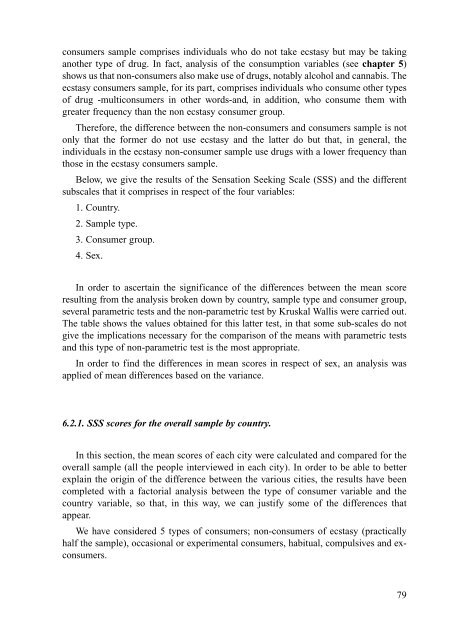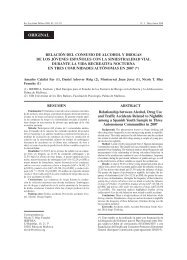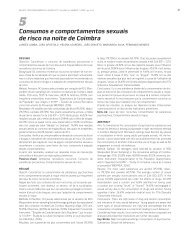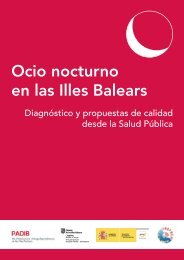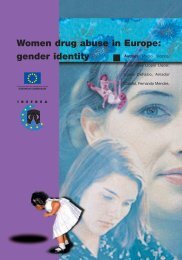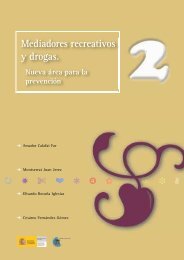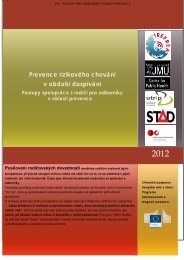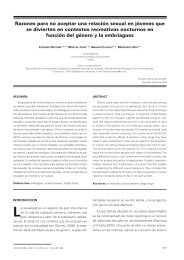Characteristics and social representation of ecstasy in Europe - Irefrea
Characteristics and social representation of ecstasy in Europe - Irefrea
Characteristics and social representation of ecstasy in Europe - Irefrea
You also want an ePaper? Increase the reach of your titles
YUMPU automatically turns print PDFs into web optimized ePapers that Google loves.
consumers sample comprises <strong>in</strong>dividuals who do not take <strong>ecstasy</strong> but may be tak<strong>in</strong>ganother type <strong>of</strong> drug. In fact, analysis <strong>of</strong> the consumption variables (see chapter 5)shows us that non-consumers also make use <strong>of</strong> drugs, notably alcohol <strong>and</strong> cannabis. The<strong>ecstasy</strong> consumers sample, for its part, comprises <strong>in</strong>dividuals who consume other types<strong>of</strong> drug -multiconsumers <strong>in</strong> other words-<strong>and</strong>, <strong>in</strong> addition, who consume them withgreater frequency than the non <strong>ecstasy</strong> consumer group.Therefore, the difference between the non-consumers <strong>and</strong> consumers sample is notonly that the former do not use <strong>ecstasy</strong> <strong>and</strong> the latter do but that, <strong>in</strong> general, the<strong>in</strong>dividuals <strong>in</strong> the <strong>ecstasy</strong> non-consumer sample use drugs with a lower frequency thanthose <strong>in</strong> the <strong>ecstasy</strong> consumers sample.Below, we give the results <strong>of</strong> the Sensation Seek<strong>in</strong>g Scale (SSS) <strong>and</strong> the differentsubscales that it comprises <strong>in</strong> respect <strong>of</strong> the four variables:1. Country.2. Sample type.3. Consumer group.4. Sex.In order to ascerta<strong>in</strong> the significance <strong>of</strong> the differences between the mean scoreresult<strong>in</strong>g from the analysis broken down by country, sample type <strong>and</strong> consumer group,several parametric tests <strong>and</strong> the non-parametric test by Kruskal Wallis were carried out.The table shows the values obta<strong>in</strong>ed for this latter test, <strong>in</strong> that some sub-scales do notgive the implications necessary for the comparison <strong>of</strong> the means with parametric tests<strong>and</strong> this type <strong>of</strong> non-parametric test is the most appropriate.In order to f<strong>in</strong>d the differences <strong>in</strong> mean scores <strong>in</strong> respect <strong>of</strong> sex, an analysis wasapplied <strong>of</strong> mean differences based on the variance.6.2.1. SSS scores for the overall sample by country.In this section, the mean scores <strong>of</strong> each city were calculated <strong>and</strong> compared for theoverall sample (all the people <strong>in</strong>terviewed <strong>in</strong> each city). In order to be able to betterexpla<strong>in</strong> the orig<strong>in</strong> <strong>of</strong> the difference between the various cities, the results have beencompleted with a factorial analysis between the type <strong>of</strong> consumer variable <strong>and</strong> thecountry variable, so that, <strong>in</strong> this way, we can justify some <strong>of</strong> the differences thatappear.We have considered 5 types <strong>of</strong> consumers; non-consumers <strong>of</strong> <strong>ecstasy</strong> (practicallyhalf the sample), occasional or experimental consumers, habitual, compulsives <strong>and</strong> exconsumers.79


